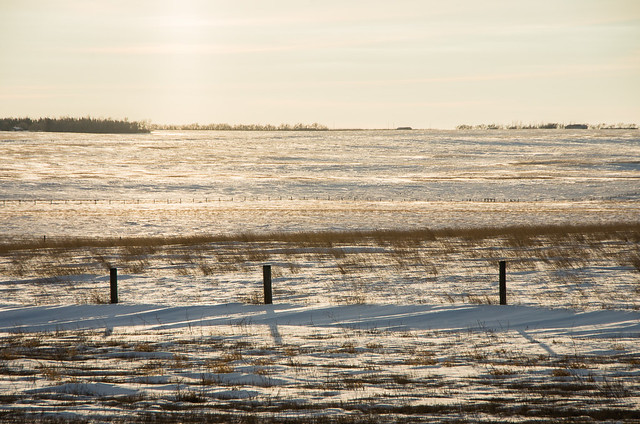“Most of our thinking is centred around the immediate – today and tomorrow. We need to be thinking seven generations out,” says
Janet McVittie, Assistant Professor, College of Education, University of Saskatchewan. “That’s hard to do when you’re young, but I’m hopeful that starting environmental education at a younger age will have an effect.”
Purpose and Parameters
There are several different forms of education around environmental issues.
Environmental education focuses on teaching ecological concepts and principles, such as the definition of an ecosystem or the balance between predator and prey. “They teach students
about the environment, but the programs are not necessarily action-oriented or experiential, nor do they necessarily challenge the status quo,” explains Janet.
Outdoor education encompasses educational programs that take place out of doors. Most Saskatoon programs fit into this category. Outdoor education programs teach students to observe and to learn by doing. “It’s not enough to simply spend time outdoors,” Janet says. “Teachers can help students to view their surroundings critically. For example, one teacher took his students to the same spot in each of the four seasons, and he asked them questions: Where does the water in the creek go? How does it affect the areas downstream?”
“Outdoor education teaches
about the environment
in the environment. It’s experiential,” Janet explains. “However, unless the teacher provokes critique and action, it does not necessarily teach
for the environment.”
Janet stresses the importance of discussing issues from a local perspective. “Issues such as poverty are complex. It’s easy to think we’ve solved the problem by sending money to Guatemala. By starting at the local level and moving to the global level, children appreciate that these are complex issues,” she explains. “Social and ecological justice issues are intertwined. One cannot heal the environment without resolving issues of inequity.”
Programs in Saskatoon

Saskatchewan has only one formal environmental education program. Other than in that program, environmentally committed teachers are responsible for taking the courses they teach and working them around environmental topics.
“It’s an advantage to not have an environmental education curriculum as it allows teachers to take a critical, action-oriented approach,” Janet says. “But teachers are also at a disadvantage as they have to fit the environmental courses around the existing curriculum.”
There are some Saskatoon programs that teach students about the environment while in the environment. These include programs at the
Brightwater Science and Environmental Centre, the
Blackstrap Outdoor/Environmental Center, the
Ed and May Scissons Environmental Centre at Eagle Creek, and the nature-based programs offered by the
Saskatoon Zoo Society, the
Meewasin Valley Authority, and
Wanuskewin. Transportation costs and the small size of the programs limit how many students can participate.
The Province of Saskatchewan recently introduced a new science curriculum for grade 11 students. The
Environmental Science 20 course description states that, “Students will learn how to examine local and global environmental issues from a systems perspective while considering the effects of human actions and a growing global population on the climate and environment, as well as the effects of the environment on human health.”
“The new program expects teachers to take their students outdoors,” Janet says, “but it’s hard to get outside in the regular 60-minute class. You need places close to the school, such as a community garden or a native plant garden.”
Moving Forward
A term that is coming into use is education for sustainability. It recognizes the connections between the environment, social justice, and the economy. For example, why do we place toxic waste dumps in northern Saskatchewan or locate garbage dumps next to poor neighbourhoods? How do we measure the cost of mitigating the environmental damage caused by extracting natural resources? Why are resources inequitably distributed?
Janet has met environmental educators from other provinces and believes that we see environmental education differently in Saskatchewan. “In Saskatchewan, we connect environmental and social justice issues and we support both formal (intentional, evaluated) and non-formal (workshops, tours) approaches,” she explains. “We take an action-oriented approach. We want to make children aware of the political process so that they can become involved.”
The new Bachelor of Education program at the University of Saskatchewan supports this approach. It focuses on helping beginning teachers to build the curriculum around the important issues of the day.
All teacher candidates now take a course called
Pedagogies of Place which helps them find learning resources in their communities. Also addressed in the course are experiential, inquiry-based instructional methods and assessment for learning processes to support students developing competency in their inquiries. They also take a course called
Ethical Beginnings which addresses social justice. Addressed in the course are critical approaches to teaching and learning, for examining and challenging the status quo.
Why It Matters
In an age dominated by technological advances, it’s increasingly important for all of us to balance our online time with outdoor time. Environmental education programs are crucial for ensuring that children spend time outdoors and learn to appreciate nature.
Additional Resources
SaskOutdoors
EcoJustice, Greater Saskatoon Catholic Schools
Outdoor School, Saskatoon Public Schools
EcoQuest, Saskatoon Public Schools
Let’s Lead Nikanetan
Photo Credit: Alyssa Wiebe, College of Education, University of Saskatchewan






















